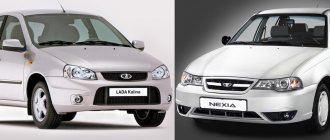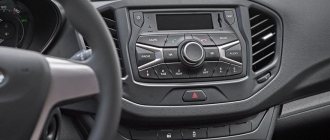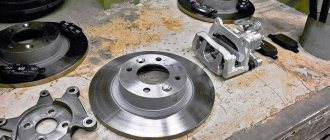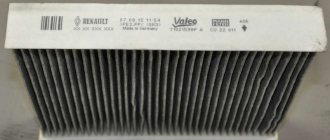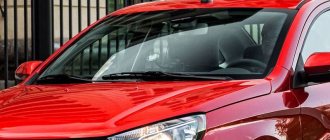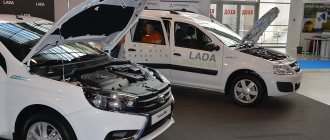The new domestic Lada Vesta sedan attracted the interest of many people who were planning to buy a car. However, when the Lada X-Ray hatchback was released, many were confused as to which was better. Give preference to a familiar and comfortable sedan at a low cost, or still pay more and get a powerful and practical hatchback.
Lada Vesta or Xray, which is better? To answer this question correctly, it is necessary to compare such vehicle parameters as interior, technical characteristics, maneuverability, speed and fuel consumption, equipment and price.
Interior of Lada X-Ray and Lada Vesta
As for the interior decoration of the models, it produces a pleasant effect. The cars look quite impressive, it is worth noting that the similarity of the models is immediately noticeable. The general style of the dashboard, a dashboard with wells, elongated air deflectors, a center console, almost the same steering wheel, comfortable seats, a rear sofa with a harmonious profile.
Salon X Ray
Salon Vesta
In addition, cars have such a positive quality as visibility. The side mirrors are large enough to allow you to clearly see the situation behind you.
Don’t forget that Vesta is a sedan, so there is quite a bit more space in the rear cabin. X Ray wins with his height.
dimensions
Let's start comparing Lada Vesta and Lada X-Ray with overall parameters. The cars are different in size because the bodies are different. But since both models are built on the same platform (B0), the differences are not particularly large.
Vesta is longer, and this is due to the presence of a separate trunk. This parameter is 4410 mm, versus 4165 for the hatchback. They are the same in width - 1174 mm, and in height Vesta is only 3 mm lower, this figure for X-Ray is 1570 mm. Their wheelbase also differs: for the sedan it is 2635 mm, and for the hatchback it is 2592 mm. The X-Ray is a “pseudo-crossover”, so its ground clearance is quite good - 195 mm, but Vesta is not far behind it, it has a ground clearance of 178 mm, that is, the sedan is also well suited for our roads.
Another important parameter is the size of the luggage compartment. And this is where the body features come into play. The X-Ray has a minimum volume of 361 liters, while the Vesti has a larger trunk - 480 liters. But in a sedan the volume is static, but in a hatchback the compartment can be increased by folding the rear seat, and significantly. After the transformation, the trunk size increases to 1207 liters. here you will have to choose - either an enlarged compartment, but in the cabin, or a separate one, with also good performance, but without the ability to increase it.
Engine characteristics
As for engines, the Lada X-Ray still has the advantage. The manufacturer offers a choice of 3 engines at once, which cannot be said about the Lada Vesta, since there is no choice here, and only one engine is offered.
If we talk about general features, then for both cars a domestic engine of the VAZ-21129 series is produced. Engine power is 106 horsepower. The unit has a reliable and simple design: 4 cylinders and 16 valves, as well as a distributed fuel injection complex.
- The Lada Vesta can be accelerated to 100 km/h in 11.2 seconds, the X-Ray in 11.4 seconds, despite such a small power.
- As for the maximum speed, the difference is small. X Ray overtakes Vesta by 1 km/h (176 versus 175 km/h).
- Fuel consumption also has a slight difference: Vesta - 9.3/6.9/5.5 liters, X-Ray - 9.3/7.2/5.9 liters.
However, Lada X-Ray can offer its customers several more engines with 110 and 122 horsepower. The first option reaches speeds of up to 184 km/h and has a volume of 1.6 liters. The second one is a little more powerful: the maximum speed here reaches 186 km/h, the volume is 1.8 liters. As for fuel consumption, it is almost the same for both cars.
Related articles:
TTX Lada x Ray
LADA XRAY_Zahod
This is the first photo of Xray without camouflage.
The photo was taken in the Pilot Production, where several dozen machines intended for testing and testing technological processes were assembled. We were asked to hold off on publishing other photos of finished cars. This is the first photo of Xray without camouflage. The photo was taken in the Pilot Production, where several dozen machines intended for testing and testing technological processes were assembled. We were asked to hold off on publishing other photos of finished cars.
This is the first photo of Xray without camouflage. The photo was taken in the Pilot Production, where several dozen machines intended for testing and testing technological processes were assembled. We were asked to hold off on publishing other photos of finished cars.
I don’t know about anyone, but Boo Andersson hypnotizes me. Because you can look at three things endlessly - at fire, at water and at how Boo talks about his factory.
— This is our motor production. The assembly of Renault H4Mk engines (114 hp) began on June 24 - two thousand units have already been sent to Avtoframos, and by the end of the year we will make another nine thousand. We are also mastering the new 123-horsepower 1.8 VAZ-21179 engine, which will go primarily to the XRAY. Look how clean it is all around - Europe! We have invested millions of rubles in renovating toilets, changing rooms and workers' rest areas.
What does the president of AVTOVAZ care about toilets? Andersson cares about everything. And if one day it turns out that somewhere under his skin he has a powerful chip sewn in, I won’t be surprised: not one of the top managers, neither from ours nor from “theirs,” dumped so much information on me in a unit of time.
Characteristics of gearboxes
Both cars have identical transmissions. Both models have an AMT-type robotic gearbox and a pair of five-speed manual ones. The only difference here is that Vesta can be equipped with either a domestic or French transmission. X-Ray only has French ones.
In general, the gearboxes operate smoothly, without gear slippage or unpleasant noise. What’s typical is that you won’t find a classic automated gearbox on any model. In order to save money, a robotic gearbox was installed, which affects the ride - more jolts and jerks, a delayed reaction to reverse gear. However, you can get used to it.
Comparison of platforms
The main difference between the new generation of VAZ products is the technological platform. The Xray is based on the Renault Sandero platform, but has received a retuned suspension with different springs, a slightly wider track and strengthening of some components. Hydraulic power steering gave way to electro-hydraulics, and the ABS system was provided by Bosch. From the body part of the “renault” platform, only the load-bearing part with the floor panels and the engine shield remained. Everything else, including the roof, rear door, fenders and hood, was developed by VAZ themselves.
In turn, Vesta flaunts a completely new platform, developed specifically for Russian operating conditions. Here, as on the raised hatch, MacPherson struts are used at the front and a torsion beam at the rear; subframe for engine mounting; lower location of the steering rack; and electro-hydraulic power steering from Nissan. At the same time, the new platform is more resistant to temperature and mechanical loads, and the body structure includes special reinforcement zones, allowing one to expect a higher result in EuroNCAP crash tests. According to AvtoVAZ's expectations, the X-ray should receive three stars, like its French platform brother, but Vesta expects at least four.
Equipment and prices of Lada Vesta and Lada X-Ray models
If we consider similar levels of the basic configuration of models, then the Lada X-Ray has a cost more than the Lada Vesta - 589 thousand rubles versus 529. If we look at the top, the prices here also differ: Lada X-Ray - 742 thousand, Lada Vesta - 672 thousand.
If the buyer wants a metallic color, then the additional payment is the same - 10 thousand rubles. However, Vesta offers it for 30 thousand rubles.
As for the configuration of cars, Vesta wins here, since it offers 7 types, X-Ray - only 4.
Main differences between the models
The main difference, judging by the reviews, between the Lada-Vesta and the Lada-X-Ray is that the sedan is a car developed completely from scratch. Its development lasted for quite a long period, but people started talking about Vesta already in the early stages of construction. The model is popular because people have been waiting for its appearance for a long time. With regards to X-Ray, we can say that it was not developed from scratch. The model was based on the no less famous Renault Sandero model, and it was built on the basis of the Logan, which has been tested over the years by many taxi drivers in Russia.
In this case, people get confused in their choice. They think about what is better to choose - new developments and sensations or a reliable platform that has long proven itself to be good. So far there are no exact answers to this dispute. All differences will be discussed in more detail below. Which is better - Vesta or X-Ray?
Lada x ray and Lada Vesta photo
Body
Some drivers choose a car based on the prestige of a particular brand. However, in this case this factor is minimal, since both models are produced by the same company. Many people judge prestige by looking at the body; they differ between Vesta and X-Ray.
Vesta is produced only in a sedan body, but in the near future the plant is preparing to present other versions to the public: a hatchback, a station wagon, a version with increased ground clearance and a car with an extended wheelbase. The latter will be produced in limited quantities, but this version looks more prestigious than the others. Many VAZ car lovers are looking forward to these new items.
"X-Ray" is available for free sale only in the hatchback body. Some people believe that the model is a crossover, but this is not so. For fans of light off-road driving, AvtoVAZ is still preparing a version of the XRAY Cross, which can be considered a full-fledged crossover. Changes in the new product will be minimal: all-wheel drive, increased ground clearance, various body linings and other improvements.
If you like sedan cars, then it is best to choose the Lada-Vesta. If you like “pseudo-crossovers”, the size of which is slightly larger than that of other cars, then it is better to give preference to “X-Ray”. There are no suitable options for station wagon lovers at the moment, but Vesta should soon appear in this body style. The same applies to those who like crossovers for overcoming light off-road conditions. AvtoVAZ is preparing Xray Cross for them.
